#and phenomenology in art!!
Explore tagged Tumblr posts
Text

gender spock and the intrinsic sense of vulnerability in an exposed back
#star trek#star trek tos#s’chn t’gai spock#my art#spock#if vulcans have tails#spock the master of masculinity and femininity#also#i could talk about vulcan takes on aesthetics and art and how it ties to phenomenology#for fucking hours#approaches to art and the concept of beauty in a logical way is so interesting to me
5K notes
·
View notes
Text
Theories of the Philosophy of Expression
The philosophy of expression explores the nature, significance, and implications of human expression in various forms, including language, art, music, and body language. It delves into questions about the origins of expression, its relationship to identity, culture, and society, and its role in human communication and understanding. Additionally, it examines ethical and aesthetic considerations surrounding expression, as well as the philosophical frameworks that underpin different modes of expression.
The philosophy of expression encompasses various theories and perspectives that seek to understand the nature and significance of human expression. Some prominent theories include:
Mimetic Theory: This theory, proposed by Plato and Aristotle, suggests that art and expression imitate or reflect reality. It emphasizes the role of art in representing the natural world and conveying universal truths.
Expressivism: Expressivism posits that expression, particularly in language and art, serves as a means for individuals to express their inner thoughts, emotions, and experiences. It emphasizes the subjective and personal aspect of expression, focusing on the individual's unique perspective.
Semiotics: Semiotics, developed by Ferdinand de Saussure and Charles Peirce, explores the study of signs and symbols and their interpretation. It examines how meaning is conveyed through linguistic and non-linguistic signs, highlighting the role of context and cultural conventions in interpretation.
Pragmatism: Pragmatist philosophers like John Dewey emphasize the practical consequences of expression. They argue that expression serves a functional purpose in communication and problem-solving, shaping social interactions and facilitating collective action.
Hermeneutics: Hermeneutics focuses on the interpretation of texts and cultural artifacts, including literary works, religious texts, and artistic expressions. It examines the process of understanding and meaning-making, considering the role of context, tradition, and the interpreter's perspective.
Aesthetic Theory: Aesthetic theories, developed by philosophers like Immanuel Kant and Arthur Schopenhauer, explore the nature of beauty and artistic experience. They examine how aesthetic judgments are formed, the criteria for evaluating art, and the relationship between art and morality.
Phenomenology: Phenomenological approaches, as developed by Edmund Husserl and Maurice Merleau-Ponty, explore the lived experience of expression. They focus on the first-person perspective and the embodied nature of expression, examining how individuals perceive, interpret, and engage with the world through expression.
These theories offer diverse insights into the complexities of human expression, highlighting its multifaceted nature and its significance in shaping individual and collective experiences.
#philosophy#epistemology#knowledge#learning#chatgpt#education#ontology#metaphysics#psychology#Philosophy of language#Philosophy of art#Philosophy of music#Body language#Communication#Identity#Culture#Aesthetics#Ethics#Human experience#Mimetic theory#Expressivism#Semiotics#Pragmatism#Hermeneutics#Aesthetic theory#Phenomenology#Interpretation#Meaning-making
18 notes
·
View notes
Text

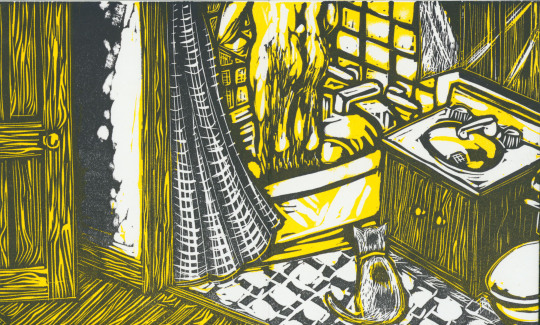
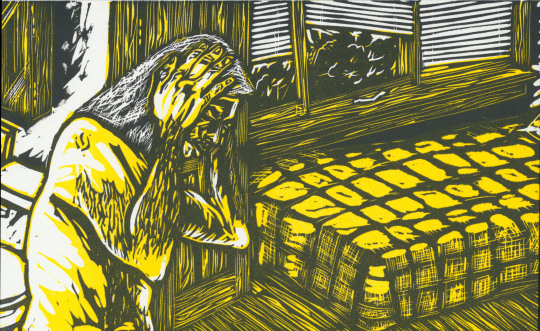
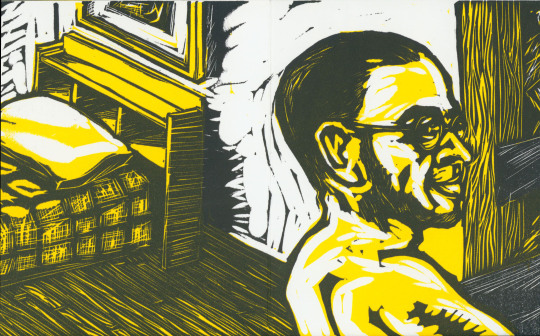
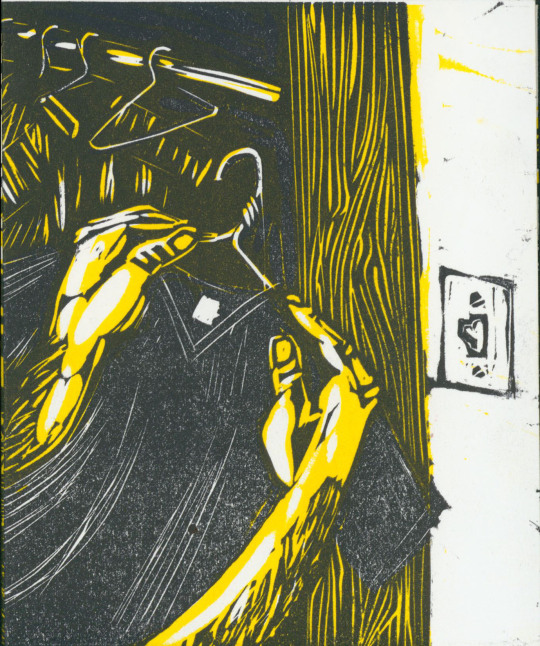
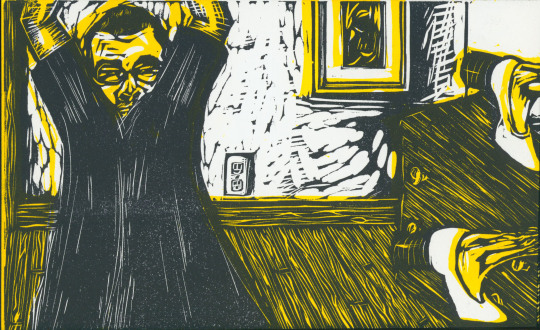

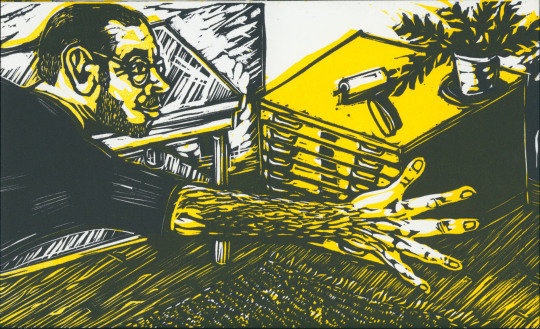
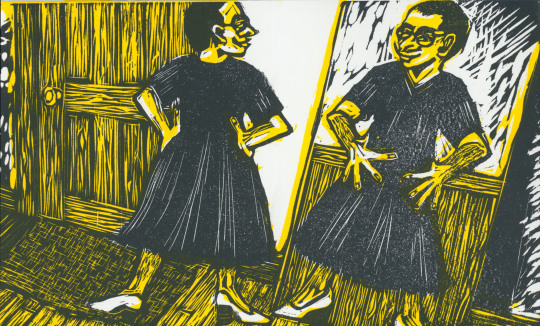
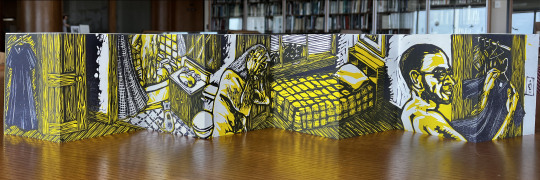

Good Bye!
This is my last post as Special Collections Graduate Intern. I am now a Master of Fine Arts and I am using this post as an opportunity to share some of my own work.
My Dress, is an accordion-folded artists book printed from four hand carved linoleum blocks. Two blocks on each side of the single sheet, yellow and a deep navy. Conceived of in 2021, published in 2023 as a small boxed edition of 4. This copy will be a part of the UWM Libraries' Special Collections.
The book was a part of my thesis exhibition, In Here, Out There. My exhibition was about the work of 'becoming' queer, work typically done in safe interior spaces, like our homes where we can play and experiment with our how we perform gender. The work of 'becoming' queer involves orienting oneself towards objects that allow you to imagine new possibilities of being. In this book that object is my dress that I carefully select from my closet and pull on over my head, I then joyfully fly through the apartment and the book to the mirror in which I appreciate the work I have done.
I will be staying in Milwaukee; I love this city and have an amazing supportive community here. I will have a studio at the House of RAD and I will be teaching workshops at Anchor Press Paper and Print! Including one on creating a linocut accordion fold book, much like this one. So, keep a look out!
Also, come and see Boyfriend Material, an exhibition of Queer Milwaukee based artists, including myself, curated by artist and curator, LaNia Sproles. Open May 22 – July 15, 2023 at the Brooks Stevens Gallery, located at MIAD, 273 East Erie Street, Milwaukee.
Follow my work on Instagram @teddylepley, and on my website Teddylepley.com.
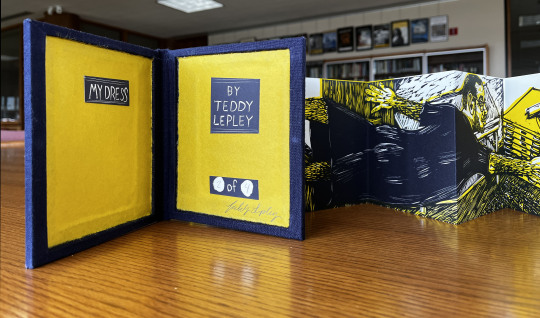
Read more posts by Teddy! Read more Fine Press Friday Posts!
Thanks for reading! Too-da-loo,
Teddy Dean Lepley III, M.F.A.
#queer art#queer artist#artists books#linocut#relief printmaking#printmaking#bookmaking#book art#artists#uwm special collections#my dress#teddy lepley#teddy#mfa#emerging artists#phenomenology#goodbye#fine press fridays#fine press friday#LGBTQ+#UWM LGBT Collection
86 notes
·
View notes
Text
unfortunately if i ever developed the lifeseries orv au in my head in earnest i would in no capacity whatsoever manage to be normal about it at all and like. i mean it
#like . genuinely. so much of orv deals with metafiction & the act of art literally coming to life through#reading/watching/observing it (schrodingers cat) (both dead and alive) (your gaze the determining factor) (a witness to existence)#& how characters turn into real people & vice versa & fiction intermingling with reality#and its that character bit that i am kinda obsessed with esp in mcyt spaces from a phenomenological standpoint#for example in smps where roleplaying elements are light and the characters the ccs are playing as#are much closer to themselves than they are actually characters#AND LIKEEEE THIS IS KIND OF ORVS ENTIRE DEAL REALLY#this act of being percieved and witnessed and characterized by yourself and others#the different social conventions between how we treat ppl as characters vs ppl as human beings#how every person is unto themself a story and how fiction is a tool used to preserve life#to resurrect the dead#to love someone with all your heart despite never actually truly ''knowing'' them#only having an imperfect reconstruction of their existence entirely based on your perception of them#how much of you is ''real'' versus ''fiction'' ? genuine versus persona?#does it matter?#and like. explodes. its so everything to me. its so everything. its not nornal. this is not a mormal way to engage with media#but there is a narrative mechanic that involvws cosmic twitch streaming as metaphor for the audience & performance & stage & storytelling#and i cant just NOT think about it in tandem with whatever it is i have going on here#you tell these stories to keep others alive... to keep yourself alive.. to stave off death...#like... this combined w the endless death game timeloop that is the life series is just#really... important to me... the watchers less as eldritch beings and more true to their metaphor as audience stand ins#greedily devouring the story because its all that we have left#this perpetual act of death and rebirth a preservation of life a celebration of their stories#somethign we cherish and champion and hold close.. something that allows all of us to live#for just a little bit longer#see i. i. yeah. not normal. not nornal at all
14 notes
·
View notes
Text






Some photos from my recent series “Silly Rabbit the Kids Tricketh Once more” which explores the disorientating, disruptive and often transformative relationships queer bodies invoke in everyday spaces that have been assumed to bare a “straight” neutrality or orientation.
#feminist art#tomisinanimashaun#photography#film photography#photographers on tumblr#queer#queer artist#queer theory#queer artwork#queer community#queer photography#queer phenomenology#queer writers#philosophy#conceptual photography#concept art#contemporary art#contemporary photography#marginalized communities#marginalisation#orientation#blackartist#afro surrealism
2 notes
·
View notes
Text
Artist Statement, Antony Gormley
Things already exist
Sculpture already exists
The job is to transform what exists in the outer world
by uniting it with the world of
sensation, imagination and faith.
Action can be confused with life.
Much of human life is hidden.
Sculpture, in stillness, can transmit what may not be seen.
My work is to make bodies into vessels
that both contain and occupy space.
Space exists outside the door and inside the head.
My work is to make human space in space.
Each work is a place between form and formlessness,
a time between origin and becoming.
A house is the form of vulnerability,
darkness is revealed by light.
My work is to make a place, free from knowledge,
free from history, free from nationality to be experienced freely.
In art there is no progress, only art.
Art is always for the future.
Published in Antony Gormley: Five Works, Serpentine Gallery, London: Arts Council of Great Britain, London, 1987 (source)
51 notes
·
View notes
Text

#hegel#phenomenology of spirit#homework notes#notes#doodles#art#homework doodles#discussion notes#philosophy
2 notes
·
View notes
Text
Pokémon Scarlet and Violet: Arting with Hassel, a Hassel appreciation post

One of the features I enjoyed about Pokémon Scarlet and Violet were the optional classes; many of which were optional. This was a perfect way to include content such as lore for world-building and additional opportunities for interacting with teachers and staff outside of class to give more depth to NPCs without falling into the hand-holding linear formula that Pokémon often fell prey to in previous generations, most notably generation seven with Pokémon Cut Scene Version Pokémon Sun and Moon.
Each of the classes has a purpose insofar as they introduce players to game mechanics, exposition, or general lessons that are simply important in and of themselves. The class that left the best impression on me during my first blind playthrough of Pokémon Violet was the art class because of a single quote from Hassel,
"It is true that one doesn’t need art to survive... But it certainly makes surviving much more enjoyable!"
There are many who think art is a waste of time. Hassel even acknowledges this in his preface to the class: “I imagine that many of you will forget all that you learned in this class once you graduate! After all, you don’t need even a basic understanding of artwork, much less a refined appreciation of beauty, for most exams or jobs.” When you compare it to other classes of the Academy roster like home economics, history, biology, or maths, the art class seems the least useful, doesn’t it? Many today even make fun of people who pursue fine arts because of how “useless” and “impractical” they are compared to other more esteemed choices that almost every parent would prefer a million times over!
The truth of the matter is that those people who are quick to denounce the validity of art or artistic endeavours are the same people who know little about how impactful and infulential art truly is in our daily lives. From the shows we like to watch to the music we like to listen to, art has served humankind as an outlet for self-expression and innovation. There are essential parts of intentionality and the human condition—things that make us humans, human.
Once upon a time I, The Average Melli, encountered many others who not only dismissed the value of arts entirely, but condescended anyone who would want to “waste their time” on something that “wouldn’t benefit society” or “make good money.” One person once said that “schools should stop teaching art altogether to focus more on subjects that students would actually need in life like the sciences or maths.” The person saying this was a Computer Science major who was deeply disappointed by others around them if they decided to become educators or earn a a degree that didn’t relate to STEM fields. This person further mocked others when they suggested that they would “all be working at fast food joints” while they would have a stable and plentiful income. Everybody would want them and they would always have a job, they prided themselves.
At the time, I called them out and didn’t allow them to condescend others over choosing non-STEM paths. What people like this don’t realise is that when someone pursues the arts, how much money they’ll make is not a large factor. Money is nice, but most people who choose to commit to the arts already know they won’t be making a lot of it. The commitment to the arts is instead fueled by an ambition that those who see them wasteful may never understand. The artist isn’t after a thicc paycheck or a Nobel Prize. The artist is someone who unapologetically expresses themselves and their ideas in an authentic way.
Hassel embodies the heart of an artist as a character who ran away from home to chase his own dreams as a pianist instead of succeeding his father as the head of his family of Dragon Tamers. Interactions with him outside of class reveal how persistent his relatives are about getting him to return and how disappointed they are in him for making a life for himself on his own terms, doing what he loves most. Hassel’s backstory hits home for any person who has ever disappointed others by doing something they love to do, or following their own dreams instead of conforming to the expectations of others.
For some of us, art is more than a hobby or a side-gig. It’s a way to share glimpses of our inner-worlds with other humans through different media be it a song, a story, a video game, a movie, etc. Art is so much more than drawing a pretty picture. When Hassel says
“it is true that one doesn’t need art to survive... But it certainly makes surviving much more enjoyable,”
he’s right. It has no practical use in and of itself, but art makes the world a place worth living in. Art is why some of us are still living today. In the darkest of times, art serves as a safe haven and healthy alternative for coping with the most unfortunate circumstances.
The way I see it, there is a difference between living and being alive. “Alive” is merely an adjective that describes a passive state of existence for a noun; “living” is a verb, an action to be taken by nouns. Human ingenuity and cognition are not guarenteed or propelled by mere existence alone or being thrown into the world by chance. Creating, progressing, engineering, thinking outside of the box--human cognition is driven by action, by living.
We don’t need art. But for many, being able to appreciat the beauty in the world as Hassel encourages in art class makes being alive, mere survival, worth it. It gives some of us a reason to keep going. For many, art is speck of meaning that continues to shine against the nihilistic pessimism of the modern age. Art class isn’t about basic life skills like cooking or financial management, but as Hassel says,
"it is my hope that this class will add even a little bit of color to your lives."

References
Hassel Quotes section on Bulbapedia
I don’t quote it directly, but I am influenced by phenomenology! I recommend Martin Heidegger’s book, Sein und Zeit (Being and Time) in which he discusses at length concepts I’ve alluded to above such as geworfenheit, or being “thrown into the world.”
I also recommend The Human Condition by Hannah Arendt for more on “action” as a defining feature of what makes us human!
#pokemon#pokemon scavio#pokemon scarlet#pokemon violet#pokemon scarlet and violet#pokemon hassel#elite four hassel#hassel pokemon#philosophy#art#gaming#video games#phenomenology#hassel appreciation post
29 notes
·
View notes
Quote
The body's animation is not the assemblage or juxtaposition of its parts. Nor is it a question of a mind or spirit coming down from somewhere else into an automaton; this would still suppose that the body itself is without an inside and with out a 'self.' There is a human body when, between the seeing and the seen, between touching and the touched, between one eye and the other, between hand and hand, a blending of some sort takes place - when the spark is lit between sending and sensible, lighting the fire that will not stop burning until some accident of the body will undo what no accident would have sufficed to do. ...
Maurice Merleau-Ponty, “Eye and Mind”, Primacy of Perception, 163-164
49 notes
·
View notes
Text
Spruzzò heikel xafava vesikas rêvera - Entity N° 16042
Mixed media on A4 paper (21 x 29,7 cm , 350 gr.)

View On WordPress
2 notes
·
View notes
Text
Phenomenology of the Body
Phenomenology (contents of consciousness) of the Spirit was introduced by Hegel and I diverge from his creation to the phenomenology of the body. Instead of phenomenology of the spirit I introduce Senseonciousness (from sense and consciousness) and senseonciousness satisfies the experience of the body. All information is gathered and processed by the senses and they can objective and subjective experiences. Objective consciousness is the sense datum registered the mind. It can also be called empirical consciousness. For example, I observe a table and it becomes part of sensational consciousness. It becomes a fact registered in the mind. Objective consciousness involves perception and cognition. Subjective consciousness on the other hand is lyrical, poetic and sublime. What is lyrical consciousness? It’s the recognition of the self as a perfect being. It’s the self-pampered with love. It’s metaphoric allusion with positive affirmation. It’s a body having in-the-body experiences. It’s a saturation of pathos. A poetic consciousness is the amour felt by the body. It’s the nectar of love. It’s a poem of ecstasy. It’s a lyrical beatitude. It’s the language of music. It’s a cherub greeting of a lover. It’s an art of copulation. What is sublime consciousness? It’s a positive affirmation of consciousness. It’s an earthindence (earth and transcendence).
#Anand Bose#Hegel#Literature#Literary theory#Philosophy#Phenomenology#Phenomenology of the body#Geist#Aesthetics#Art#Senseonciousness#Earthindence
3 notes
·
View notes
Text
this might be dropkicking a hornet’s nest but I don’t think “ah but this art made you experience an Emotion” is actually a useful or clever take on modern (or any) art and kind of maybe misunderstands what it means to say “Art makes you think about/feel things.”
Like. My experience with (visual) art is honestly kind of universal regardless of the emotional or aesthetic veneer and at the risk of outing myself as a phenomenologist, it really is the experience of seeing and the art becoming art in front of you. Rothko’s paintings work in person because it pulls you in and the more you stare at it and really look the more layers you see and the more the medium shows itself to you and it becomes an oil painting and also colors and also canvas and pigment and linseed oil and wax and also an infinite number of things. And this isn’t any different across mediums/styles/movements. Staring at a tramp art box and seeing every knife cut and the faded logos and careful joinery from another life; staring at the old Dutch master portraits and being in a room with someone you can’t stop looking at; jumping at a tromp l’oeil before realizing it’s a painting; seeing a quilt and understanding the neat rows of stitches diving into the batting; gazing up at a giant marble statue and seeing the ancient scaffolding waver and blend into the impossibly smooth curves.
I could fill every empty page in my apartment with similar descriptions but I think it makes the most sense if you’ve ever watched a meteor shower. You have to let your eyes adjust to the darkness and you think every flicker of light is a shooting star until suddenly you can see and something burns across the sky and you realize you’ve seen it and everything prior was something else.
Idk I think a side effect of “getting” art is not being able to see anything without wondering how it got here and who is responsible for it existing and why. “I could make that” is an astronomically annoying way to interact with the world but it’s a step closer to something genuine than “ooo you’re angry and that means it’s working!”
#putting this in the tags for obv reasons but honestly this is why I’m open to ai art#staring at a picture with baffling text and too many fingers and teeth and seeing how the algorithm works is cool#like it works as a medium for me in a particular context and when it’s weird as hell#using it to make yogurt ads feels like a waste but we use all sorts of mediums for cynical capitalist ends#idk I just like art and also got handed phenomenology and existentialism as a 19 year old#so we can’t really be surprised I’m Like This#but if you are wondering how to start liking art (even weird modern art) just stare at it in person#go to a craft fair or find cool digital artists and just 👁️👁️#mine#text post#void screams#art#modern art#ai art discourse#ai art#art discourse
2 notes
·
View notes
Text
infinite vs. finite qualia
Qualia can lay on spectrums. The qualia of redness lies on a color spectrum. The qualia of freezing lies on a temperature spectrum.
These spectrums can be finite/infinite, or bounded/unbounded if you prefer.
Finite qualia would be where you know the range of possible experiences. For example, with colors you know that any color you see will land somewhere on the rainbow or RBG wheel. With temperature, what you feel lands on a finite spectrum from freezing to burning.
Infinite qualia would be where you could conceivably encounter new qualia you've never experienced before that don't fit on a bounded spectrum. For example, you can taste new foods that don't taste like any food you've tasted before. You can hear sounds with a timbre unlike anything you've ever heard before. You can smell things that don't smell like anything you've ever smelled before. You don't know the bounds of what it's possible to experience.
2 notes
·
View notes
Text

2 notes
·
View notes
Text
multidisciplinary fields i love you
#going from reading hard science isotopic studies#to ethnic boundary maintenance theory#to labour and capitalism#to the hierarchical intimacies of the senses#sometimes i get so stressed about deadlines i forget that this is actually fun and interesting#archaeology :)))#like yes tilley i know youre talking about phenomenology but talking about how taste is the most intimate of the senses because#it requires taking things into your own body#vs sight which is the most distanced and is basically just remote sensing and therefore less intimate#like.... alright king let me use my academics for my art#To be a good phenomenologist is to try to develop an intimacy of contact with the landscape akin to that between lovers. like okay......
7 notes
·
View notes
Text

All I want to eat today is fortune cookie. 🍪
11 notes
·
View notes